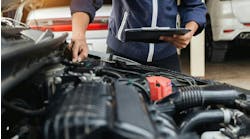“When you stop growing you start dying.”
That oft-cited quote from American writer William S. Burroughs is emblematic of the collision repair industry. As another wave of consolidation sweeps through the country, independent shop owners are continually being required to grow. To keep up with DRP programs. To keep up with retaining talent. To keep up their customer base. Growth is required to maintain all of those key aspects of business.
And growth can be defined in many different ways, from adding employees to opening new stores to simply increasing revenue.
In this month’s feature, three successful shop owners share their unique stories of growth and give advice on what other shop owners need to do to continue to thrive. As you’re reading, remember each shop's goals are different. But there are several core tenets that can help guide any type of growth in this time of rapid consolidation.
Responsible doesn’t have to mean slow.
Every business wants to grow in a sustainable, responsible way. But too often, shop owners root that desire in the need to be cautious or deliberate, says Joseph Bassett, who sold his 11-store MSO to Crash Champions and is now the VP of Operations at Crash.
Bassett grew his business from one location in 2018 to 11 locations by 2021. It was a combination of taking “comfortable risks,” which he recommends for all shops regardless of how aggressive-natured they are, and a realization that growing slower was actually going to be more detrimental for him than growing rapidly.
Comfortable risks
—
Joseph Bassett, former owner of 11-stores MSO and now the VP of Operations at Crash Champions, advises all shop owners to take “comfortable risks.”
“Don’t get over your skis. If it doesn’t feel good, don’t do it. Everybody is nervous about doing deals, extending themselves or taking a risk. Take comfortable risks. That was always my thing, if it didn’t feel good, I didn’t do it.”
Bassett says that emcompasses everything. The timing of adding locations. The financial situation it would put you in. Adding employees. Trust your gut and intuition, Bassett says, it got you this far.
“I discovered quickly if you weren’t a MSO, people weren’t putting you on the insurance programs,” says Bassett, whose stores were located in Florida and were quickly losing insurance business to the incoming MSOs in Classic Collision and Crash.
Bassett was able to capitalize during COVID, when he says most of the industry—both MSOs and independents—were “asleep at the wheel.” Bassett did not lay off any employees and instead went into growth mode, franchising several locations through CARSTAR and then plucking several more stores per year until he eventually sold the business.
It ended goals he had of becoming a large regional operator of 40 to 50 stores. But ultimately receiving an opportunity to sell to Crash was “too good to pass up.”
His key to growing quickly? “Execution.”
“It takes a unique breed. But I’ll say, the good operators that are all over everything all the time, they’re the ones that don’t fail. The ones that grow responsibly know how to execute.”
Crucially, they know how to create a growth plan and execute on it. That’s the case for Dan Morrow, owner of Morrow Collision Center, a three-store operation in Nebraska.
SHOP STATS: Morrow Collision Center Location: 3 Locations in Lincoln, Nebraska Operator/s: Dan Morrow Shop Size: Biggest is 26,000 square feet Total Staff Size: 37 Annual Revenue: $5 million
Morrow’s growth timeline was much slower from his genesis of owning a shop, but once he began growing, it happened rapidly.
From 2002 to 2019, there wasn’t much growth happening for the business. Morrow operated a single location for the entire time. But in his mind, he had lots of ideas. How he could add on to his current space? What would adding another location mean for his workers? He had grown the business to eight employees and had pretty much maxed out the space. And critically, how could he secure funding?
“Somewhere down the line I decided I wanted to skip the middle stage of growth,” Morrow says. “Some start where they can, work for five or 10 years and then jump to a bigger shop in an industrial neighborhood. Then they get that going, by the time they’re in the place to build their dream shop they are going to retire,” Morrow says.
And what enabled Morrow to take that jump was a bank willing to loan him the money necessary to make the jump. He struggled for several years to find one that would give him the green light.
But while that can be looked at as risky, Morrow had years of planning and thinking built up when the opportunity finally arose. So when he secured the funding, the floodgates for growth opened. Soon he added a 26,000 square foot facility with the “ideal location, ideal space, ideal everything.” Then in 2021 he bought a third shop. He went from $1 million in revenue with the one shop to over $5 million with the three.
“Over those years we collected ideas,” Morrow says. “We would think about certain processes. Some processes that I thought were good ideas and a year later I came up with a better way. It was constant updating.”
From how to hire new employees, to understanding what type of facility Morrow wanted to add next, those years of waiting to pounce on an opportunity ensured that when it was time to go into growth mode, he knew how to do it responsibly and not recklessly.
Looking back, Morrow still characterizes his moves as risky, but the rapid growth came together smoothly because of planning that was put in place.
Understanding your background is imperative.
Bassett was comfortable growing from a single location to 11 locations within three years because of his extensive background in the industry. Prior to running his own operation, he worked on the executive teams of Caliber, Classic and AutoNation. Through those experiences, he had the institutional knowledge of how to grow and was able to scale quickly after opening his first location.
But that’s not the norm for most shop owners, who often either begin as a technician and graduate into shop ownership or have it passed down through the family.
Jay Flores is a second-generation owner of Tony's Body Shop of Oxnard, California. Flores’ parents opened the shop in 1965 and it was passed down to Flores in the 1990s. In that time, Flores has transitioned it from an open-air, three-walled shop that the family was renting from a gas station to a 31,000 square foot facility. But it took time, and plenty of learning to get there, Flores says.
SHOP STATS: Tony's Body Shop Location: Oxnard, California Operator/s: Jay Flores Shop Size: 31,000 square feet Total Staff Size: 31 Average Monthly Car Count: 120–150 Annual Revenue: $6 million
When he took over the business, his only experience came through watching his parents struggle with the business. He says they were part of the large contingent of small businesses that were open but weren’t making any money. They didn’t know the intricacies of how to run a business. So Flores knew if he was going to grow, he needed to be educated.
“I grew business through education and leaving my cubby,” says Flores.
He began to take classes through 3M. Then he joined AkzoNobel’s 20 Group. There he learned the basics of profit and loss, crafting a business plan and how to set up marketing (more on that later). He got out of Oxnard and had meetings with shop owners around the US, touring them and learning about their businesses. He wasn’t afraid to ask what he didn’t know and to take ideas from other businesses. He joined Mike Anderson’s Spartan 300 Group and got involved in the California AutoBody Association and has had meetings with the state’s department of insurance. All with the goal of learning and growing.
“You have shops around me that aren’t willing to leave their cubby and be exposed to the world. To see a shop that is nice. To see a shop that is well-run. Why reinvent the wheel? Talk to each other,” Flores says.
That mindset allowed him to grow from having just a handful of employees to now 31. In 2005, he moved out from his older facility to a 25,000 square foot facility that he has since expanded to 31,000 square feet and pushed his revenue to about $500,000 per month.
He understood he didn’t know enough to be successful. He watched his parents struggle and it is the “fire that drives” him to continue learning and growing. But to do it, it took some self-realization that he didn’t have all the answers. He was around the business his whole life, but he knew he needed to experience other shops’ workflow and processes. And he’s seen many shop owners try to grow without having the requisite knowledge to do so.
“Some of my friends say ‘we want to be like your shop, Jay.’ Well I look at it like this, if you want to become a doctor, you need to go to school and spend years learning. To become a good shop owner, you need to be educated and expose yourself to other good operations,” Flores says.
Flores recommends joining different industry groups and conducting outreach to other shops. If you don’t want to go visit a competitor, go outside your market to find a shop that’s willing to have you. Flores says there are plenty more shops that will open their doors than will keep you out.
Marketing enables all types of growth.
The biggest piece of advice Flores picked up through his many years of education was the importance of marketing. That’s the introduction of ads through TV, radio and Facebook. But it is also as simple as the shop giving each customer some toffee nuts as they leave. Or sending customers thank you letters. Or clearly explaining the customer’s warranty options so you make sure they come back next time.
“It doesn’t need to be exhaustive, what’s important is you give it some thought. But if you don’t, you have a business that you’re waiting for things to fall out of the sky and they will not,” Flores says. “Most shops have no marketing plan. Their marketing plan is to get on DRP programs and get work that way.”
As a shop that gets very little work from DRP programs, and sees those programs as a negative for most shops, Flores has had to prioritize a very active marketing plan in order to bring in business.
He also sees a marketing strategy as a fallback option for shops that do have DRPs. For a while, Flores did have several DRPs, but slowly those carriers began to prioritize other shops in their program and pushed Flores to make cheaper and cheaper repairs. To Flores, in order to have sustained growth, shops shouldn’t rely on DRPs to funnel them business. They need to have an organic way of getting customers through the door.
“You control your workflow. You control your following of customers. The carriers, they’re good today and bad tomorrow,” he says. “Look at it this way, if you don’t have a marketing plan, you have nothing more than someone saying, ‘I’m going to feed you tuna for lunch and if you don’t like tuna then too bad.’"
Flores sees the marketing plan as a vital aspect to maintaining sustainable growth. And for shops that have DRPs, they should have a backup plan so they don’t have an outside force influencing their growth. After removing DRPs, Flores says he went from having 10 cars moving in and out each day to about five. However, they haven’t had any drop off in sales.
And while many view marketing as just an external strategy used to bring in new customers, Flores sees marketing as a vital part of any type of growth. He says his marketing efforts have helped attract new employees, who see that the shop has plenty of work and that it is a well-run organization.
To Flores, the amount of work has always been a deciding factor for potential employees. They want to know that they’ll have work to do when they get to the shop, and the money Flores has spent on marketing assures that.
Sticking with what's working
—
While Bassett's and Morrow’s growth has come by adding more locations, Flores has prioritized growth within his one location. He considered adding more shops and has been presented with the opportunity multiple times but has turned it down.
“I’ve had the opportunity to open multiple stores and it’s just not me. Why open a store when you’re already two-and-a-half times the size of a normal shop?” Flores says.
Flores has enjoyed the positives that owning a single-location store presents and is an example that growth doesn’t always need to include adding more locations.
Sidebar: Quick Tips
Don’t hire just to hire
“Having the wrong technician is worse than having no technician,” says Morrow.
When growing, it can become easy to be less stringent in your hiring standards because you just need bodies in the shop. But even for as fast as Morrow grew, he knew hiring a bad technician would lead to a further delay in production than hiring nobody.
Prioritize relationships
The third shop that Morrow bought was one he had his eyes on for a while. Four years prior to buying it, he had talked to the owner and said if he ever wanted to sell it, to call him. Sure enough, the owner was ready to retire a few years later and gave Morrow a call.
Now, Morrow doesn’t recommend going to every shop and saying you’re interested, He had a previous relationship with the owner and was able to parlay that into a later sale. Morrow recommends just having relationships with the shops all around you. Be friendly and make a good impression. Don’t act like a consolidator, Morrow says.
Build a network of “fans”
Bassett’s biggest tip for attracting talent during growth is to “build a network of fans who enjoy working for you.” This industry talks, Bassett says, and if employees like where they work, they will tell others.
“Take care of the people you currently have. Pay them well and they will tell others,” Bassett says, adding he didn’t have trouble hiring or scaling during COVID because of this mindset.
He was also 100 percent transparent with his workers about his growth plan. That allowed his employees to help recruit others because they knew the organization was growing and that their own positions wouldn’t be threatened.
In the same way, for businesses that fail, Bassett says it is frequently related to the lack of follow through. They don’t keep promises to employees, vendors or lenders.
“When you say you're going to do something, do it,” Bassett says. “Operate with integrity and good things will come.”
Stay on the forefront of tech
Flores has inherently kept his shop growing because he’s been willing to jump in on new technology. His shop is Tesla-certified and his shop can calibrate vehicles and do ADAS work. Because he was willing to invest in new technology, that has opened up new profit opportunities that have continued to grow the business.
“In my eyes, the collision industry has changed and I have changed my business model to make it not only survive, but to thrive with these changes,” Flores says.



